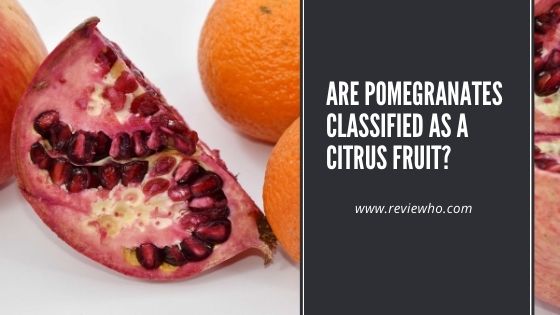Are pomegranates classified as citrus fruit? You might have tasted some pomegranates and then wondered if they are a citrus fruit. To be honest, they have an amazing flavor, just like citrus fruit does. They also have an amazing smell, similar to citrus. However, when you look at the interesting and unique structures they have, it might be hard to classify them as citrus fruits. So, is pomegranate a citrus fruit?
Fact is, several vegetables are classified as fruits and vice versa. So, pomegranate might be a citrus fruit. But is that the case? Let’s check it out.
What is a Citrus Fruit?
Citrus fruit is in the Rutaceae family. Fruits in this family are known to have thick skins with an extreme vitamin C concentration.
Additionally, the skin of the fruits in this family has certain oil inside their skin. This oil is mainly used in the production of fragrances. The skin covers the segments that have vesicles filled with amazing juice.
You may know most, if not all, of the citrus fruits. They are mainly oranges, limes, lemons, clementine, pomelos, citrons, kumquats, bergamots, and several more.
Are Pomegranates Part of the Family?
Is pomegranate a citrus fruit? Well, no… Pomegranates are not citrus fruits. They are, instead, from the Lythraceae family. Citrus fruits, as we noted earlier, are in the Rutaceae family. With that in mind, it is safe to say that there is no relationship between the two.
Pomegranates are found in different parts of the world. However, their native origin is from India to Iran. They have been grown and harvested in the Mediterranean basin for a very long time. They are native to Australia, Asia, as well as Oceania.
However, even though they are different from oranges, they can be combined to blend a perfect juice or smoothie.
What is Pomegranate?
Is pomegranate citrus? We have concluded that it’s not. So, what exactly is it?
Pomegranates are a certain berry. They have seeds that are produced by the ovary from one flower. These seeds are protected and found inside the fruit.
Compared to most fruits, these are quite different in regards to the layout. Pomegranate fruit has chambers that are not symmetrical. These chambers feature edible seeds. Thinking of it, the layout and structure seem similar to citrus fruit. After all, they have a couple of chambers that have mini-compartments with juice.
However, a slice of citrus fruit has many vesicles that do not have seeds. They are also thin. The vesicles found in citrus fruit are separate from the seeds. The seeds are right in the wedge’s center.
Pomegranates, on the other hand, do not have vesicles. Instead, they have sarcotestas. These contain juice and seeds together. The juice and skin are edible. The seeds, on the other hand, are not edible even though they are many.
Vitamin C Content
Is pomegranate citrus considering the vitamin C content? Considering the vitamin C content, you will note the difference between these two. Even though citrus fruits do not have the highest levels of vitamin C, they do have a lot compared to pomegranate fruits.
For instance, 100 grams of pomegranates have 10.2 milligrams of Vitamin C. 100 grams of oranges has 53.2 milligrams of vitamin C. Lemons feature 52 milligrams. With this comparison in mind, you can note the huge difference between the two.
The Flavor
Pomegranates have a certain sour and tart note in their flavor. You might confuse this for vitamin C, but it is not. The Citric acid content is responsible for this flavor. I understand the confusion. Isn’t it a citrus fruit if it has citric acid? Well, many fruits have some levels of citric acid but are not classified as citrus fruits.
Citric acid is edible and it occurs naturally and is found mainly in most citrus fruits. However, it is also available in tomatoes, strawberries, cherries, cranberries, and pomegranates, the topic of our discussion.
With that in mind, you should know that citric acid received its name from citrus, mainly because it occurs mostly in citrus fruits. Nevertheless, that is not the only source. Citrus fruits are only the highest source.
What you can do with Pomegranates
We have concluded that pomegranates are not classified as citrus fruits. Regardless, there are many amazing ideas you can use with citrus fruits. Here is a couple of them.
Juice + Pomegranate Juice
You can make a juice using a combination of pomegranate and oranges. They produce a very delicious and beautiful blend of fruit juice. You might realize that it is not the sweetest drink in the world. Nevertheless, it gives you a very tropic vibe. That being said, you should realize that there are more fruits you can blend with pomegranate to get a smooth juice.
Include them in A Salad
Pomegranates are quite beautiful if you think about it. You can take advantage of that beauty in a salad. You simply need to sprinkle them on a fruit salad. If you have fruits such as pineapple, mangoes, or pares, you can add them to get that amazing blend.
It is also a great idea to use them in a tasty salad. If you consider the color, they are a perfect addition. The only red ingredient in a salad is either pepper or tomatoes. They are an amazing sweet option and will give you an amazing appearance.
As a Coloring
Pomegranates are extremely red, which gives them the power to stain anything. You can take advantage of this aspect. If you have an icing that would look great with a pink shade, simply add some pomegranate.
In case you require a deep red, simmer it for a short while and it will reduce.
Remember, when you add pomegranate, it will become sour.
Conclusion
Is pomegranate citrus? We have looked at different aspects and conclude that it is not classified as a citrus fruit regardless of the taste or appearance. Nevertheless, there are different amazing ways in which you can use pomegranate. Make sure to give it a try. Have fun.
Also, read: What are the Differences Between Gala vs. Fuji Apples
Feel free to share your observation with me in the comments section!
Also, if you find the information in this post to be useful, be sure to share this post with your friends on Facebook, Twitter, and Pinterest.




